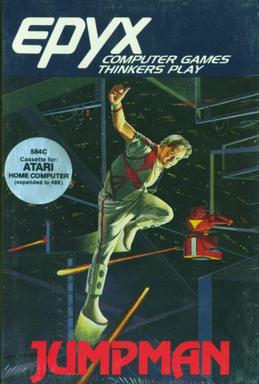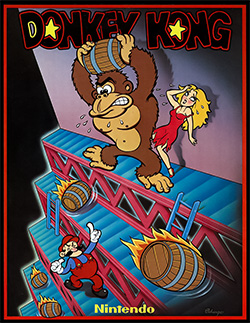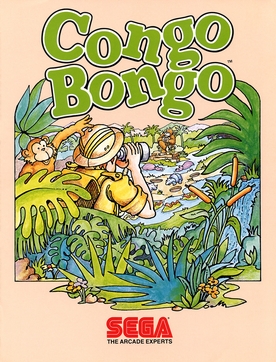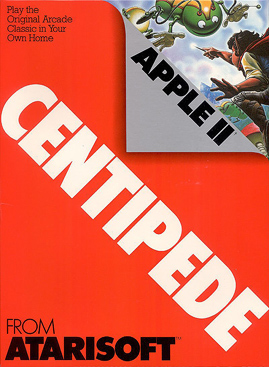
Coleco Industries, Inc. was an American company founded in 1932 by Maurice Greenberg as The Connecticut Leather Company. It was a successful toy company in the 1980s, mass-producing versions of Cabbage Patch Kids dolls and its video game consoles, the Coleco Telstar dedicated consoles and ColecoVision. While the company ceased operations in 1988 as a result of bankruptcy, the Coleco brand was revived in 2005, and remains active to this day.

ColecoVision is a second-generation home video-game console developed by Coleco and launched in North America in August 1982. It was released a year later in Europe by CBS Electronics as the CBS ColecoVision.

A platformer is a sub-genre of action video games in which the core objective is to move the player character between points in an environment. Platform games are characterized by levels that consist of uneven terrain and suspended platforms of varying height that require jumping and climbing to traverse. Other acrobatic maneuvers may factor into the gameplay, such as swinging from vines or grappling hooks, jumping off walls, air dashing, gliding through the air, being shot from cannons, using jet packs, or bouncing from springboards or trampolines. Games where jumping is automated completely, such as 3D games in The Legend of Zelda series, fall outside of the category.

Jumpman is a platform game written by Randy Glover and published by Epyx in 1983. It was first developed for the Atari 8-bit family, and versions were also released for the Commodore 64, Apple II, and IBM PC.

The Coleco Adam is a home computer and expansion device for the ColecoVision by American toy and video game manufacturer Coleco. The Adam was an attempt to follow on the success of the company's ColecoVision video game console. It was available as Expansion Module #3 for the ColecoVision, converting it into a home computer, and as a standalone unit. As such, it had the benefit of being entirely compatible with all ColecoVision games and peripherals. The computer came with 64 KB of memory, a tape drive for a proprietary medium called Digital Data Packs, a daisy wheel printer, and productivity applications, along with two DDPs for SmartBASIC and Buck Rogers: Planet of Zoom Super Game. It was released in October 1983 with the initial price of $700.

Miner 2049er is a platform game developed for the Atari 8-bit family of home computers by Bill Hogue and released by his company, Big Five Software, in 1982. The player controls Bounty Bob through multiple levels of a mine, with the goal of traversing all of the platforms while avoiding or defeating enemy mutants. At a time when "climbing games" such as Donkey Kong had four screens, Miner 2049er had ten.
1983 has seen many sequels and prequels in video games, such as Mario Bros. and Pole Position II, along with new titles such as Astron Belt, Champion Baseball, Dragon's Lair, Elevator Action, Spy Hunter and Track & Field. Major events include the video game crash of 1983 in North America, and the third generation of video game consoles beginning with the launch of Nintendo's Family Computer (Famicom) and Sega's SG-1000 in Japan. The year's highest-grossing video game was Namco's arcade game Pole Position, while the year's best-selling home system was Nintendo's Game & Watch for the third time since 1980.

Popeye is a 1982 platform game developed and released by Nintendo as an arcade video game. It is based on the comic strip of the same name created by E. C. Segar and licensed from King Features Syndicate. Some sources claim that Ikegami Tsushinki did programming work on the game. As Popeye, the player must collect hearts thrown by Olive Oyl from the top of the screen while being chased by Brutus. Popeye can punch bottles thrown at him, but can only hurt Brutus after eating the one can of spinach present in each level. Unlike Nintendo's earlier Donkey Kong games, there is no jump button. There are three screens.

Donkey Kong Jr. is a 1982 arcade platform game that was released by Nintendo. It is the sequel to Donkey Kong, but with the roles reversed compared to its predecessor: Mario is now the villain and Donkey Kong Jr. is trying to save his kidnapped father. It first released in arcades and, over the course of the decade, was released for a variety of home platforms. The game's title is written out as Donkey Kong Junior in the North American arcade version and various conversions to non-Nintendo systems.

Jungle King, re-released as Jungle Hunt, is a side-scrolling action game developed by Taito and released for arcades in 1982. It was originally distributed as Jungle King, then quickly modified and re-released as Jungle Hunt due to a copyright dispute over the player character's likeness to Tarzan. Jungle King, along with Moon Patrol released a month earlier, is one of the first video games with parallax scrolling.

Donkey Kong is a 1981 arcade video game developed and published by Nintendo. As Jumpman, the player runs and jumps on platforms and climbs ladders to ascend a construction site and rescue Pauline from a giant gorilla named Donkey Kong. It is the first game in the Donkey Kong series as well as Mario's first appearance in a video game.

Congo Bongo, also known as Tip Top, is an platform game released as an arcade video game by Sega in 1983. A message in the ROM indicates it was coded at least in part by the company Ikegami Tsushinki. The game is viewed in an isometric perspective, like Sega's earlier Zaxxon (1982), but does not scroll. Numerous home ports followed.
1982 was the peak year for the golden age of arcade video games as well as the second generation of video game consoles. Many games were released that would spawn franchises, or at least sequels, including Dig Dug, Pole Position, Mr. Do!, Zaxxon, Q*bert, Time Pilot and Pitfall! The year's highest-grossing video game was Namco's arcade game Pac-Man, for the third year in a row, while the year's best-selling home system was the Atari 2600. Additional video game consoles added to a crowded market, notably the ColecoVision and Atari 5200. Troubles at Atari late in the year triggered the video game crash of 1983.

Atarisoft was a brand name used by Atari, Inc. in 1983 and 1984 to publish video games for non-Atari home computers and consoles. Each platform had a specific color for its game packages: video games sold for the Commodore 64 were in green boxes, games for the TI-99/4A in yellow, the IBM PC in blue, and so on.

Space Panic is a 1980 arcade video game developed by Universal. Predating Nintendo's Donkey Kong, and lacking a jump mechanic, Space Panic was the first game involving climbing ladders between walkable platforms. The genre was initially labeled "climbing games," but later became known as platform games. A ColecoVision port by CBS Electronics was released in the winter holiday season of 1982.

Apple Cider Spider is a three-screen platform game written for the Apple II by Ivan Strand and published by Sierra On-Line in 1983. A Commodore 64 port followed. The player takes the role of a spider in an apple cider factory. The goal is to progress through three screens to reach the top of the factory, to join the company of other spiders.
Christian H. "Chris" Oberth was a video game programmer who began writing games for the Apple II in the late 1970s. He also developed handheld electronic games for Milton Bradley, arcade video games for Stern Electronics and other companies, and ported games to home computers and consoles.

Jumpman Junior is a platform game written by Randy Glover and published by Epyx in 1983 for the Atari 8-bit family and Commodore 64. In 1984, a port was released for ColecoVision in Australia, France, Germany, Italy and the UK. It is a follow-up to Jumpman (1983). While Jumpman has 30 levels, Jumpman Junior has 12–all of which are different from the previous game. The game was reduced in scope so it could be released in cartridge form.

Troll's Tale is an adventure video game developed in by Sunnyside Soft and published by Sierra On-Line for the Apple II in 1983. It uses the same engine for Sunnysoft's earlier game Dragon's Keep. Sierra acquired the game from Sunnysoft, along with Dragon's Keep and Bop-A-Bet by April 1983 and appointed Nancy Anderton to manage the publishing of their educational games. Peter Oliphant converted the games for the Atari 8-bit family, Commodore 64 and, as a self-booting disk, IBM PC compatibles. Coleco made a deal with Sierra planning to release the game on ColecoVision with a Super Game Module. The game came packaged with a paper map, showing an incomplete layout of the game and stickers to mark the treasure locations.

Threshold is a space-themed fixed shooter written by Warren Schwader and Ken Williams for the Apple II and published by On-Line Systems in 1981. Inspired by Sega's Astro Blaster arcade video game, Threshold introduces many enemy ship types and wave formations as the game progresses. Reviewers found the variety distinguished the game from the many similar shoot 'em ups.
















